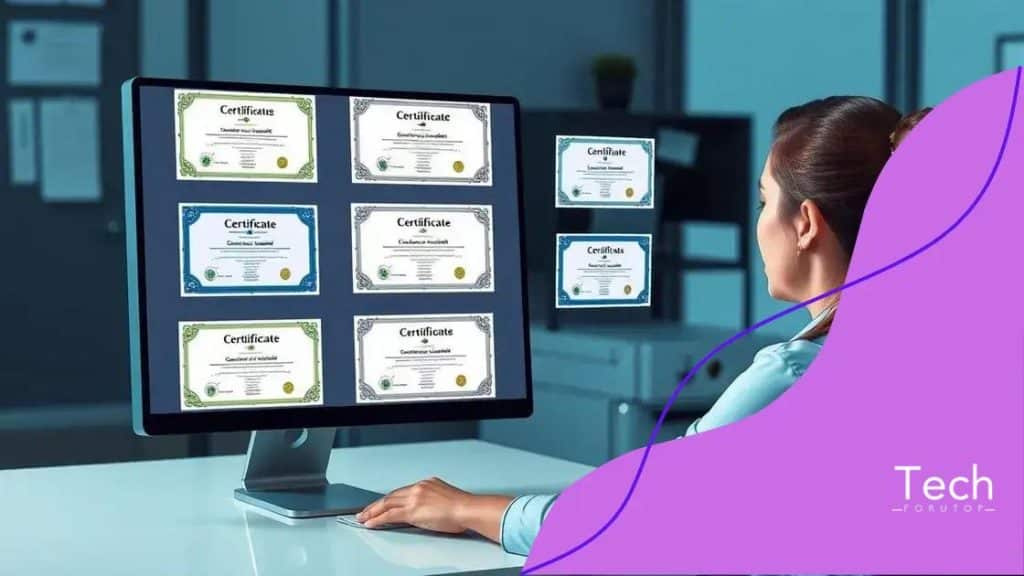Digital credentialing: the future of secure verification

Digital credentialing offers secure, efficient ways for individuals to verify qualifications and skills, aiding organizations in streamlining hiring processes while addressing challenges like security and standardization.
Digital credentialing is changing how we verify identities in the modern world. Imagine holding a trusted credential on your smartphone, freeing you from traditional paperwork. Let’s dive into how this technology reshapes our understanding of identity and security.
Understanding digital credentialing
Understanding digital credentialing is essential in today’s digital age. As technology advances, traditional methods of credential verification are transforming. Gone are the days of carrying paper certificates and IDs. Now, digital credentials provide a faster, more secure way to prove one’s identity and qualifications.
What is digital credentialing?
Digital credentialing refers to the process of issuing, storing, and verifying credentials through digital means. These can include educational degrees, professional certifications, and other forms of identification.
Benefits of digital credentialing
By using digital credentials, individuals and organizations can enjoy several advantages:
- Increased security against fraud and forgery.
- Instant access and verification by employers and institutions.
- Reduced administrative burdens and costs associated with paper-based systems.
Digital credentialing establishes trust between parties. For example, when employers assess potential hires, they can quickly verify qualifications. This speeds up hiring processes, leading to faster decisions.
How it works
The process of digital credentialing involves several key components:
- Issuers: Institutions or organizations that grant credentials.
- Holders: Individuals receiving and storing their credentials.
- Verifiers: Third parties or employers validating the credentials.
With this system, holders can share their credentials with confidence while minimizing the risk of tampering. The technology behind digital credentialing often uses blockchain or secure databases, enhancing the integrity of the provided information.
Benefits of digital credentials for individuals
The benefits of digital credentials for individuals are transforming the way we approach verification and identity. These credentials provide an efficient way for people to showcase their skills and qualifications. By going digital, individuals can have easier access to opportunities that require verification.
Accessibility and Convenience
One key advantage is accessibility. Digital credentials can be stored on personal devices, making them easy to access at any time. This eliminates the hassle of carrying physical documents.
Enhanced Privacy and Security
Digital credentials enhance privacy and security for holders. With features like encryption and secure sharing options, individuals are less vulnerable to identity theft. Only authorized parties can access this sensitive information, giving people peace of mind.
Instant Verification
Another significant benefit is instant verification. Employers can quickly confirm qualifications without lengthy background checks. This speeds up the hiring process and reduces administrative costs associated with verifying traditional credentials.
- Improved job prospects through verified skills.
- Reduced waiting time for credential verification.
- Streamlined access to new opportunities.
Furthermore, the global nature of digital credentials allows individuals to showcase their achievements to organizations worldwide. This broad reach can significantly enhance career opportunities in an increasingly interconnected job market. As more employers recognize the value of digital credentials, individuals who adopt them will likely gain a competitive edge.
How organizations can implement digital credentialing

Organizations looking to implement digital credentialing systems can significantly benefit from streamlined processes and enhanced security. Understanding how to effectively adopt these systems is crucial for success.
Identifying Needs
The first step is identifying the specific needs of the organization. Consider what types of credentials are necessary. These might include educational qualifications, professional certifications, or compliance requirements. By pinpointing the essential credentials, organizations can tailor their systems to meet their unique demands.
Choosing the Right Technology
Next, selecting the appropriate technology for digital credentialing is vital. Organizations should look for platforms that offer:
- User-friendly interfaces for both issuers and recipients.
- Robust security features like encryption and blockchain technology.
- Integration capabilities with existing systems.
After choosing a platform, proper training for staff on how to use the new technology is essential. This ensures everyone understands the process of issuing and verifying digital credentials.
Engaging Stakeholders
Involving stakeholders is another crucial factor. By engaging employers, educational institutions, and industry experts, organizations can gather valuable insights and create a more effective credentialing process. Feedback from these groups allows for adjustments that enhance the system’s effectiveness.
Successful implementation also means regularly evaluating the system for improvements. Organizations should track usage and gather feedback from users to ensure that digital credentialing systems are always meeting current needs.
Common use cases of digital credentialing
Digital credentialing has become increasingly popular, with various applications across different fields. Understanding the common use cases of digital credentialing helps organizations and individuals see its value.
Education and Training
One of the most significant use cases is in the education sector. Schools and universities issue digital diplomas and transcripts to students. This allows students to easily share their achievements with potential employers. Digital credentials streamline the application process, making it faster and more efficient.
Employment Verification
Another essential use case is in employment verification. Employers can request digital credentials from candidates during the hiring process. This ensures that the verified information is accurate and helps reduce hiring risks.
- Verification of degrees and certifications.
- Quick access to background information.
- Reduced administrative costs.
Additionally, industries like healthcare utilize digital credentialing for licensing and certification purposes. Healthcare professionals can present their credentials digitally to employers or licensing bodies, making verification straightforward and secure.
Professional Development
Another use case is in professional development. Organizations and training programs issue digital badges and certificates to individuals who complete specific courses. These credentials can be shared on social media platforms, enhancing the visibility of skills and qualifications.
By integrating digital credentialing, organizations can create a more transparent and efficient process for managing records. This also helps build trust among users, as the credentials are easily verifiable. As the world becomes more digital, embracing these use cases can provide significant advantages in various fields.
Challenges and future of digital credentialing
The challenges and future of digital credentialing are important topics for organizations and individuals to consider. While digital credentialing offers many benefits, several hurdles still need to be overcome for wider adoption.
Security Concerns
One of the main challenges is security. Digital credentials must be protected against hacking and unauthorized access. Organizations need to implement strong security measures, such as encryption and multi-factor authentication. Without these protections, the risk of credential fraud and identity theft can increase.
Standardization Issues
Another challenge is the lack of standardization across different systems. Many organizations use various platforms for issuing and verifying credentials, which can create confusion. This inconsistency makes it difficult for employers and institutions to validate credentials easily.
- The need for established protocols for digital credentialing.
- Efforts to create universal frameworks.
- Collaboration among stakeholders to address discrepancies.
As organizations address these challenges, the future of digital credentialing looks promising. With advancements in technology, solutions to security and standardization issues are being developed. For instance, the use of blockchain technology holds great potential for creating secure, tamper-proof credentials.
Growing Acceptance
The acceptance of digital credentials is also expanding. More employers and educational institutions recognize the importance of digital verification as a way to streamline processes. This trend is particularly noticeable in industries that rely on verified skills and qualifications.
In conclusion, as more organizations embrace digital credentialing, we can expect innovations that enhance security and usability. The future is bright for this exciting technology, transforming how we verify credentials across various sectors.
The future of digital credentialing is bright, as it continues to evolve and adapt to the needs of various industries. The benefits of using digital credentials are clear, offering enhanced security, efficiency, and accessibility. While challenges such as security concerns and standardization still exist, technological advancements and growing acceptance are paving the way for successful implementation. Embracing digital credentialing not only helps individuals verify their skills effectively but also streamlines processes for organizations. As we move forward, keeping an eye on innovations in this field will be essential for harnessing its full potential.
FAQ – Frequently Asked Questions about Digital Credentialing
What are digital credentials?
Digital credentials are electronic verifications of skills, qualifications, or achievements that individuals can easily share and prove.
How secure are digital credentials?
Digital credentials can be very secure, especially when protected with encryption and other security measures to prevent fraud.
What are the benefits of using digital credentials?
The benefits include faster verification processes, improved accessibility, and reduced administrative costs for both individuals and organizations.
What challenges do organizations face when implementing digital credentialing?
Organizations may face challenges such as security concerns, lack of standardization, and the need for proper technology integration and training.





